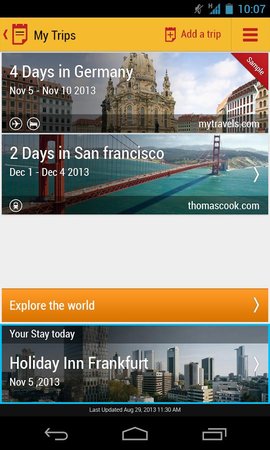Serendipity and more: what to expect from location-aware mobile apps in 2014
Travellers will have high expectations of location-aware mobile apps in the coming year and personalisation will be the key
Location aware mobile apps in the travel sector need to offer real-time, tailored information. Developers not only have to continuously capitalise on data related to apps, they also need to work out apt monetisation strategies.
EyeforTravel’s Ritesh Gupta looked to the future with Seshadri Krishnan, co-founder of Trip38, a location-aware mobile app which delivers context sensitive content.
EFT: What have been the major developments in location-aware mobile apps in the travel sector in recent years?
SK: Over the last couple of years, the proliferation of free Wi-Fi and economical smartphones, serendipity and augmented reality (AR) have been the main drivers behind users adopting location-aware mobile apps.
Such apps are about doing the work for the consumer. The apps recommend and elevate the travel experience.
To highlight these more specifically let me say that:
· Mobile apps have become smarter; they help travellers plan rather than merely providing plans, itinerary, and recommendations .
· Usability has increased in leaps and bounds with a few apps providing a fantastic user experience as the likes of the Hipmunk and others did for the web few years back.
· Augmented reality has been adopted more hence providing a more holistic travel experience.
EFT: How challenging is it to engage users of location-aware mobile apps? How can one assess the efficacy of such apps?
SK: With attention deficient users like all of us, mobile makes it even more challenging to engage users on their mobile phones.
At Trip38, we measure user engagement fanatically and few things we learnt are:
• Page views/unique visitors to our website
• Number of installs
• Number of sign-ups
• Number of trips added
• Number of likes/shares/reviews during the trip
• Time spent during the trip
For us, the more the user engages with the app when they travel, the better. We focus on the funnel and ensure the conversion at every stage remains at a high level.
The efficacy can be measured only with the actions taken using the app either to plan the trip or during the trip.
EFT: In your opinion, how has the blend of rich content, geo-location, social networks and features like augmented reality enriched trip planning?
SK: The SoLoMo effect has impact in the travel space with convergence of both usability and mobile technologies providing an excellent opportunity for mobile apps like Trip38.
For example, we can let a user know his or her next attraction and provide directions, timings, contact details, website, entry fees (if applicable) along with the time to be spent in that place.
We are also working on blending the AR feature where the user would be able to get more rich content while they are at the location. This not only enhances the trip planning (but also elevates the user experience to a new level.

EFT: How are you catering to real-time requirements of travellers? In fact, is there any real-time component?
SK: We have an option to work offline to save on data charges. You would be able to do everything on the app except the navigation information if you do not have Internet access. The app is smart enough to recognise WiFi access and provide real time information like new restaurants, and new events during travel and get it synced up when the app opens. Having said that, we sync-up a day before the trip hence the chances of real-time changes is unlikely.
EFT: How does collection of geo-data in real time offer insights to improve the experience of travellers?
SK: There is a utility value in collecting geo-data without compromising the privacy of the user but the real opportunity lies in crowd-sourcing the geo-location information and delivering it to like-minded users through personalisation to make it relevant. The experience gets redefined if the geo-data gets refined with personalisation and crowd-sourcing aspects.
EFT: How do you offer relevant offers to app users based on their preferences?
SK: We use a post-booking mobile app so we offer context-sensitive offers and coupons for attractions, events, and duty-free shops which are both time and location based on flight and hotel information.
EFT: How challenging is it to monetise location-aware mobile apps?
SK: We do not believe in-app purchases or ad based models for consumer apps like ours so we have to look at monetisation from the eco-system players like duty-free shops, attractions, events, and hotels. We feel we have to work with large aggregators who have already collected these offers to be more scalable and efficient.
EFT: What do you expect of location-aware mobile apps in the travel sector in 2014?
SK: In 2014:
· Location-aware mobile apps will be more context-sensitive and have deeper personalisation elements as part of the app experience.
· The apps will start suggesting rather than wait for the user to trigger actions.
· AR will redefine the travel experience combining the SoLoMo effect truly.

